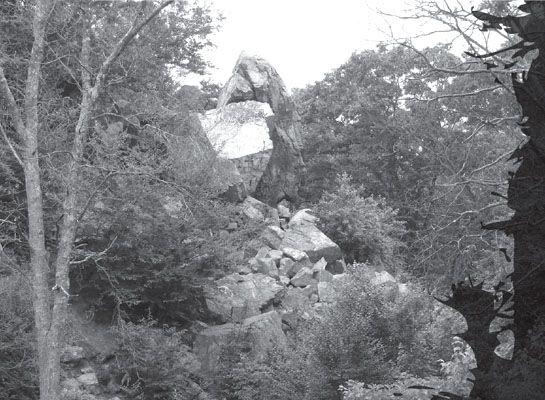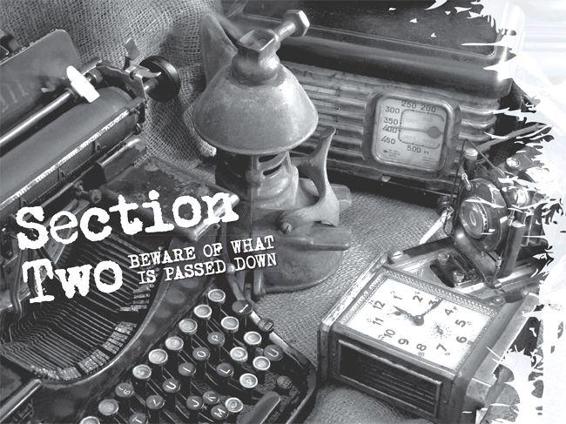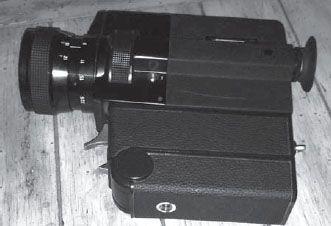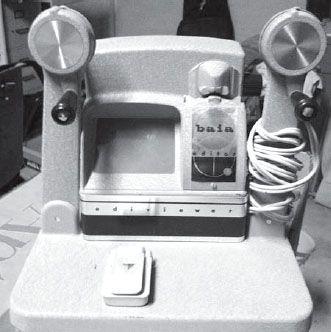Haunted Objects: Stories of Ghosts on Your Shelf (5 page)
Read Haunted Objects: Stories of Ghosts on Your Shelf Online
Authors: Christopher Balzano,Tim Weisberg

Violence and the supernatural made the forest their home long before the tribe officially made it their center. It does not end with rumors, either. So many of the ghosts in that forest—and there are many that walk among the trees—are those of Native Americans who have died. Those souls might be trapped by the belt or its agents, but one thing is certain: The hauntings show little sign of stopping.
Mediums and people who talk to the dead tell a similar story. The Triangle will continue to be a source of unexplained paranormal activity, as well as a magnet for darker elements, until a balance is restored. Even some who do not know the history cite the belt specifically as the weight that can tip the scales back. Officials within the tribe keep quiet about their views of the paranormal significance of the belt. They support the efforts to return the belt as a means of restoring their history, not to make the ghosts go away. Either way, the spirits stay and make themselves known.

Profile Rock, the haunted location where the belt was thought to exchange hands.
Both sides are looking for something different. People in the paranormal field are looking for a way to understand their relationship with the paranormal. For them, it is about the life they have now, as well as the life they may have later.
For the Wampanoag, the need is more basic. They know their past only through the eyes of the people who turned their backs on the old way. They spend time trying to retranslate a history they feel they only partly know, like trying to unravel a hand-knitted sweater stitch by stitch to make another one that looks almost the same. They do it through words now, not quite sure how to tell their tale in shells, and maybe even a bit scared that a record so fragile could once again be taken away.

Moving Moments
T
he din of the graduation dinner fades away, as the father chimes on his wine glass. He says a few proud words about his son and takes out a shiny pocket watch and hands it to him. Both are beaming as he tells how he received it from his father, who inherited it from his father, as if most of the people in the crowd don’t already to know the story. He comments on how the graduate is now a man, and the people erupt in applause. The watch will live for another generation.
If any items hold the soul of a person, even of a generation, they would be family heirlooms. They are automatic histories, not bought in a store or a pawn shop, but passed down through the family and teeming with the stories of that person’s life—and often with the weight of several lives. It is not just about the age of the item. The object is meant to be a link to the past, often a trigger for stories about the dead, and it is the act of passing it down that may actually attach the spirit to it. When that heirloom is lost or abused, or the person owning it somehow needs to hear about his or her heritage, something is triggered.
There is the story of a man who was known to crush rattlesnakes with his favorite pair of boots. One day the man dies of what seems like snakebite symptoms. His son inherits the boots, but not his father’s silliness. A few weeks later, he dies in the same way, and there are some whispers about the sins of the father. The boots find their way into the deceased son’s closet until his own son turns 16. He slips them on, remembering how much he loved his grandfather and father. He’s dead soon after, another apparent victim of the curse. But when the boots are examined after the funeral, an old rattlesnake fang sticking through the sole is found, with enough venom left on it to kill 10 men.
The story is a legend, but it points to some of the ideas behind things passed down. They can be a gateway to a time long ago, but they can also be a prison, a mistake waiting to happen again and again. In some cases, they even offer a way to release a dead relative from his or her own sadness.
Pictures are a way for us to connect to our past, even if that past is one we didn’t know we had. Today everyone has a digital camera; most people even have one on their cell phones, making them within easy reach at any given time. But we are only a couple of generations removed from the time when a camera was a cherished item few people owned and even fewer mastered. Pictures were taken carefully using a different ritual than we use today, and it was after the “click” that the real work began. Owning a camera often meant having to develop the film yourself, and the intimacy with the process brought about a different love for what was captured. The pictures were transferred to slides and shown with pride. When the first moving film cameras came out, the emotional stakes were raised. You could immortalize those important moments of your life with motion. More importantly, you could pass it down.

The camera that was handed down from grandfather to grandson.
Eli remembers having to sit through his grandfather’s slide shows, although he remembers more how he tried to stay awake as his beaming grandfather would stop at every picture and tell a story about the moment. “It’s not that his stories were boring, but I guess they were,” Eli said. “I had just seen them my whole life. I loved my grandfather, but he had a way of thinking the most uninteresting things were exciting. He never really lived outside of the area he grew up in, so a trip to upstate New York was like going to Paris.”
By the time he owned his own video camera, weighing about 10 pounds and needing to be carried on his shoulder, Eli had forgotten about most of the home movies he had seen, although he remembers the process of his grandfather taking out the projector and rolling down the screen on days when he would have rather been outside playing.
“ ‘This is history, Eli,’ he used to say. ‘Your history.’ ” He fondly remembers staying at their house, but it took him years to realize why his sisters and cousins never went through the same ritual. As the only male, his grandfather must have seen him as the family historian, the person who was responsible for passing down their traditions and their stories.
His grandfather passed away when Eli was 30 years old and lived five states away. His grandmother had died many years earlier. His uncle, who cared for the old fellow, was the one who called Eli with the news. “It tore me up, but you knew it was coming. I never had a chance to say goodbye, or at least didn’t before he died. I think that didn’t sit right with him. He had to try and find a way to come back and give me one more lesson,” Eli said.
It began the night he heard his grandfather was gone. Eli spent most of the day getting things in order so he could leave to attend the wake and funeral. He was worn out when he finally fell into a heap on the living room couch. That night he dreamed his grandfather was in the room, sitting in the chair next to where he lay sleeping. He was tapping him on the shoulder, trying to wake him up, and when Eli finally opened his eyes, his grandfather was smiling at him and trying to talk. No sound came from his lips, but he was eagerly chatting, moving his hands around excitedly.
When he arrived at his grandfather’s house, he was greeted warmly by his uncle. “I remember thinking how he didn’t seem broken up at all,” Eli said. “This was a guy who had already made peace with his father’s death. I wasn’t quite there yet.” He was more surprised that the first thing he asked Eli to do was follow him into the basement. He showed him an old cardboard box and said his grandfather was adamant in his final days that Eli must have the box.
Inside was an unorganized collection of slides and 8mm films in canisters. Buried underneath were an old-fashioned film projector and film editor and a Sankyo Super LXL 250 camera used for taking film pictures. “The thing weighed at least five pounds and ran on two AA batteries. It must have cost a fortune when it first came out, but it still ran, although I was unsure where I could get film for it,” Eli said.
After the funeral, Eli brought the box back to his apartment and placed it in the basement, where he was assigned a locked storage shelving unit. He kept the camera in his bedroom because he liked the antique feel of it. “I just thought it was cool,” Eli said. “There’s this old camera, and he had left it to me. I didn’t think much about it, but everyone commented on it. To me it was only a conversation piece. I loved my grandfather very much, but I just didn’t get into the whole picture thing. It was nice having a piece of him around, but I had no intentions of being the family documentarian or anything. I had some rocky times with my folks. Nothing too bad. I was just me, and the last thing I wanted was to be the head of anything. My grandfather had other plans, though.”

The film editor.
About two months after he died, Eli’s grandfather’s birthday arrived. It was a sad day for Eli because it forced him to think about his deceased loved one again, and he was surprised at how many of the old slide stories he remembered. It was not the details of the pictures but his grandfather’s sharing of them that remained. When he returned home from work that night, the camera was on the bed. He thought nothing of it, since he shared his apartment with several other men who frequently entered each other’s rooms looking for books or CDs. “I moved it back and made a comment to the air about Grandpa not touching my things.”
That night he had a vivid dream he could not explain. A younger version of his grandfather was walking down the stairs of his house. He was pointing to an American flag hanging from a pole in the yard and walked across the lawn to where Eli’s father, who was maybe 10 or 11, held a sparkler. His father began running down the driveway and the vision shook and then went black. He woke up and turned the light on. “I remember thinking I had just seen one of my grandfather’s old movies and when I turned the lights on, the camera was on the floor again,” he said.
The dream had an impact, especially because it seemed his grandfather was trying to communicate with him. He dressed for work, vowing to not tell anyone in his family because he thought it would upset them too much. When he got home later that night, the camera was again on the bed. “I asked my roommates if they had touched it, and they looked at me kind of weird. One said he had seen it on the coffee table earlier in the day, but he hadn’t moved it because he thought I was trying to get it to work.”
